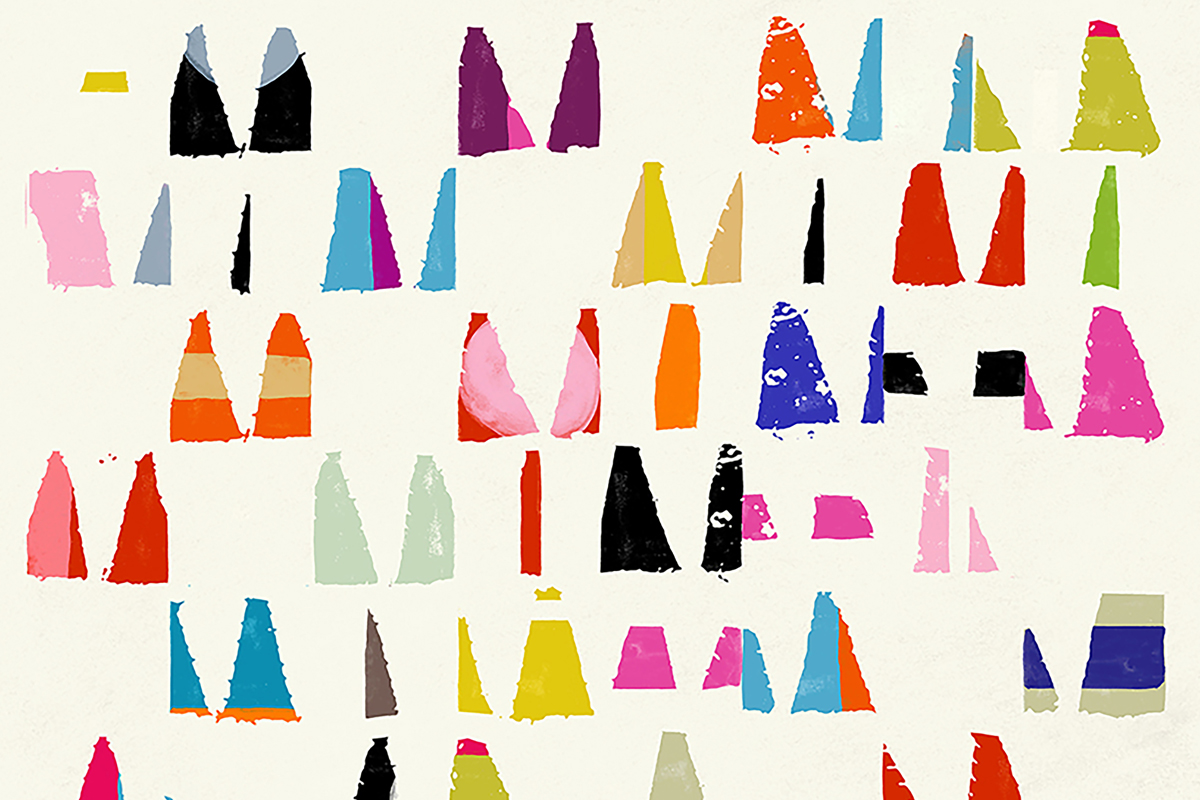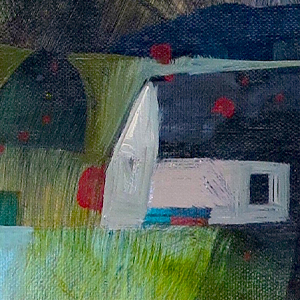
Good Academe
Touching Mathematics
Making the Work of Mathematics Meaningful
Satyan L. Devadoss
Artwork: “Ludere 4” by Jenny Frean © 2023
The Fuel of Mathematics
Mathematics has become an extraordinarily formidable agent in our modern era due to two great strengths: the permanence of its ideas and the abstraction of our thoughts. Bertrand Russell, philosopher and mathematician, echoed this as he penned these words over a century ago:
Remote from human passions, remote even from the pitiful facts of nature, the generations have gradually created an ordered cosmos, where pure thought can dwell as in its natural home, and where one, at least, of our nobler impulses can escape from the dreary exile of the actual world.1
Even science is not a domain for permanence, for science is filled with theories, not truths, from explorations of the “pitiful facts of nature.” Indeed, even established notions such as Newtonian gravity need to be updated and reevaluated. Einstein’s contribution of general relativity does just that, showcasing how gravity is altered based on the mass of the object, behaving quite differently at the quantum scale versus the cosmic scale. And string theory ideas are asking us to reevaluate gravity once again.2 Mathematics, on the other hand, is radically different: every mathematical statement, once proven to be true, becomes a bedrock of an “ordered cosmos” on which further mathematics can be built. No corrections needed.
The power of mathematical abstraction has led to the creation of computational tools built for the digital revolution. The deep machine-learning algorithms of Silicon Valley, built on the foundation of mathematics, are now impacting us in all we do, from video games and computational photography to airport security and self-driving cars. AI tools have moved from party tricks to all-purpose machines, and unlike 20th-century tech, these statistical computers are wielding a knife to careers requiring high levels of education, with impact far beyond schools and businesses.3 And the COVID pandemic has only pushed us deeper into a dependency on our smartphones, our curated entertainment platforms, and our isolated online communities. We are in an era that coerces, if not shoves us to “escape from the dreary exile of the actual world” towards isolation and disembodiment, with mathematics the fuel.
Yet, in all of this, we are humans with bodies and hands and senses. This truth pushes against the notions of permanence (our bodies will fade) and abstraction (we are profoundly embodied). And so, our driving question at the University of San Diego’s Math Play Room is: If mathematics has progressed powerfully with an emphasis on the mind, how much more can be done if we involve our bodies as well? Said differently, how can the body play a role in mathematics? This is one way we’ve sought to reconnect the work of mathematics to matter and meaning.
At our playroom, the answers come from the deep connections between thinking and doing that have been explored by psychologists and sociologists, including gesture researchers, educational theorists, and cognitive scientists. They have shown how bodily activity is essential to understanding human cognition.4 Cognitive scientists and linguists George Lakoff and Mark Johnson continue:
The evidence supports an evolutionary view of human reason in which reason uses and grows out of bodily capacities.5
Numerous disciplines have taken the idea of an intentional physical space seriously, weaving it into both pedagogical and discovery phases of their knowledge. Their art studios and science labs contain tools which both constrain and enable the experimentation process, which involves not only trial and error but also questioning and debugging. Failed experiments require reflection, adjusting, and retesting in order to understand the cause of a failure, which encourages students to take on deeper understandings of the material.
A Space for Mathematics
Philosopher Michael Polanyi writes:
The body is the ultimate instrument of all our external knowledge, whether intellectual or practical. [E]xperience [is] always in terms of the world to which we are attending from our body.6
This viewpoint led to a grant from the Fletcher Jones Foundation to renovate the mathematics department at the University of San Diego, the centerpiece being the creation of our Math Play Room, a space devoted to the learning and creation of mathematics through analog tools.
- The room is a shop to make with our hands. A wall is lined with simple tools such as duct tape, pipe cleaners, paper clips, popsicle sticks, toothpicks, yarn, glue, and fabric, with varying sizes of wood and paper stock. This pedagogical approach is influenced by rapid-prototyping techniques where the output is one of low-resolution objects that promote playfulness rather than perfection.
- The room is a studio to store since ideas do not fit neatly into one-hour blocks of lecture time. Thus, there are numerous hooks for hanging, and shelves of all sizes, for books, projects, and models. Additionally, one wall of the room is made of glass and the opposite wall is devoted to the display of creations with studio lighting, needed to excite and entice the public.
- The room is a sanctuary to highlight the human senses without the need for technological interface. A sewing machine is the most advanced electronic tool there. An entire wall is covered with a heavy slate chalkboard and colorful Hagoromo Fulltouch chalk.
A space for the work of mathematics is vital: physical action, readily available, is faster and more nuanced than symbolic manipulation. Being able to move pieces around enables learning in ways that reading and listening do not.7 Tangible objects also provide an anchor for communication where the mind’s eye is made visible, allowing everyone to observe and participate, forming a community through the performance of creation.
The Body Fights Back
The Math Play Room is part of a larger movement in our national conversation. Over the past decade, the desire for sensual experiences and the value of flesh and blood are pushing against abstraction and digitization. The realigning of the food industry, from artisanal breads and high-end coffees to ultra-premium ice creams and local breweries, calls out to a reclaiming of taste and smell. A push against the automation of food has led to the valuing of organic farming and the fight against GMOs, leading to personal gardening and homesteading. And the music commerce has turned to vinyl records, which are coveted and outshining the (technologically flawless) digital downloads. Our senses are eager to touch music and to run our fingers along the grooves of the record itself. We do not seem to trust music that has no weight.
When the pendulum swings too far into disembodiment, there is a push toward a corporeal focus on the body. With our increasing dependence on technology, there is a thirst to be with others in a physical setting, reclaiming community as humans, using our bodies to escape the trappings of our minds on the screens.
Some of the most beautiful resistance against this technological age has come from artists, many of whom eschew the digital lens through which their works are approached. Consider Chris Ware, one of the greatest graphic novelists of any era. His opus, Building Stories, is a collection of tales about a brownstone apartment building in Chicago and the tenants that lived in it over the span of decades. Ware showcases this assortment as a large box containing 14 different comic elements, from pamphlets and leaflets to hard-bound volumes and newspaper foldouts. It is designed to display the folly of linearity imposed by a digital tablet and to embrace full-on the tactile nature of exploration and storytelling.
All of this confrontation against the digital is not surprising, for decades of research has revealed the vital importance of the sense of touch in the flourishing of humanity, from pregnancies and preterm infants to patients suffering PTSD and depression.8 Scholars such as Sherry Turkle9 and Cal Newport10 warn of confusion and distraction in the digital age, where philosophers such as Charles Taylor11 caution against loneliness and loss of purpose. Critics also point to the destruction of our planet’s resources12 and the threats against equity and democracy13 that big data and machine-learning invite. As we forsake the body for the disembodied realm, something far deeper at the core of who we are fights back, pushing against the new spirituality that is forming where human flourishing is no longer a religious issue but a technological one.
The Body and Permanence
From my vantage point, the theological grid behind all of these threads is the resurrection of Jesus. In the Gospel according to Luke, Chapter 24, we find the disciples locked in an upper-room when Jesus suddenly walks through the wall and appears to them for the first time after his resurrection. While the disciples were stunned to see his presence, Jesus (and Luke), in the midst of the greatest wonder of the ages, asks for the most mundane and basic of requests: some food to eat. At this point in the story, the Christ no longer needs to carry the mantle of a body to use as a sacrificial atonement for humanity. That work has already been done. No, here is something far more radical. By this act of eating, Jesus shows that he is fully human, flesh-and-blood, for all eternity. And so, the World to Come, the permanent and everlasting kingdom, is physical in nature.14 Throughout and beyond space-time, Food matters, Touch matters, Matter matters.
Today, the Math Play Room plays a role as a pointer for the future Kingdom, where mathematics as work and ideal will thrive in abstract thought and bodily expression, satisfying our longing for permanence. For we are not asking to discard the way mathematics has traditionally been done, but offering a way to supplement it, having our bodies join our minds in the meaningful work of creating, exploring, and teaching mathematics. We hope this space, and this overall framing, will bring an attractive invitation to the next generation to take up and create mathematics with wholistic involvement, offering a haven for the embodied self.
Notes
- Bertrand Russell, “The Study of Mathematics,” The New Quarterly 1 (1907), p. 58–73.
- Brian Greene, The Elegant Universe: Superstrings, Hidden Dimensions, and the Quest for the Ultimate Theory, (W.W. Norton, 2003).
- Satyan Devadoss, “What writers can learn from mathematicians on collaborating with new technology like AI,” Chicago Tribune (opinion editorial), (September 21, 2023).
- Jiajie Zhang and Hongbin Wang. “The effect of external representations on numeric tasks,” Quarterly Journal of Experimental Psychology 58 (2005), p. 817–38.
- George Lakoff and Mark Johnson, Philosophy in the Flesh: Embodied Mind and Its Challenges to Western Thought (Basic Books, 1999).
- Michael Polanyi, The Tacit Dimension (Routledge & Kegan Paul, 1967).
- Jean Piaget, The Origins of Intelligence in Children (International University Press, 1952).
- Sushma Subramanian, How to Feel: The Science and Meaning of Touch (Columbia University Press, 2021).
- Sherry Turkle, Alone Together: Why We Expect More from Technology and Less from Each Other (Basic Books, 2017).
- Cal Newport, Digital Minimalism: Choosing a Focused Life in a Noisy World (Portfolio Press, 2019).
- Charles Taylor, A Secular Age (Belknap Press, 2018).
- Kate Crawford, Atlas of AI: Power, Politics, and the Planetary Costs of Artificial Intelligence (Yale University Press, 2021).
- Cathy O’Neil, Weapons of Math Destruction: How Big Data Increases Inequality and Threatens Democracy (Penguin-Random House Press, 2016).
- N.T. Wright, Surprised by Hope (HarperOne, 2008).
 Satyan L. Devadoss is the Fletcher Jones Professor of Applied Mathematics at the University of San Diego. A fellow of the American Mathematical Society and recipient of two national teaching awards from the Mathematical Association of America, he was faculty at Williams for nearly 15 years and has held visiting positions at UC Berkeley, UC San Diego, Ohio State, Université Nice, Harvey Mudd, and Stanford.
Satyan L. Devadoss is the Fletcher Jones Professor of Applied Mathematics at the University of San Diego. A fellow of the American Mathematical Society and recipient of two national teaching awards from the Mathematical Association of America, he was faculty at Williams for nearly 15 years and has held visiting positions at UC Berkeley, UC San Diego, Ohio State, Université Nice, Harvey Mudd, and Stanford.
Fall 2025
Part I: Employing Virtue
Chris Higgins
Anna Bonta Moreland
Karen E. Bohlin
Zena Hitz
Interlude: Meaningful Employment
Michelle Weise
Part II: Employing Vocation
MORE

















